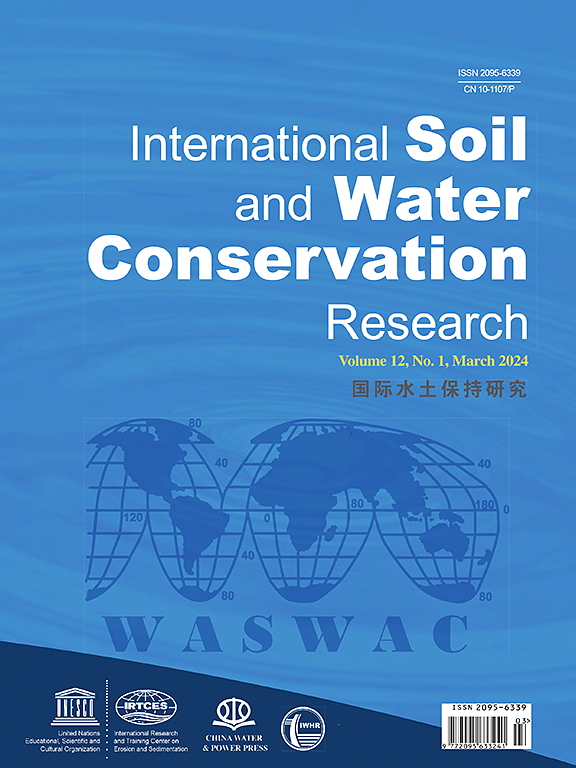Study on the shelter and sand control effect of new porous sand barriers from recycled wind turbine blades
IF 7.3
1区 农林科学
Q1 ENVIRONMENTAL SCIENCES
International Soil and Water Conservation Research
Pub Date : 2025-02-22
DOI:10.1016/j.iswcr.2025.02.006
引用次数: 0
Abstract
Aeolian disasters pose considerable threats to socioeconomic systems, ecological environments, and infrastructures such as railways and highways, in arid and semiarid regions. To reduce these problems, mechanical sand control measures are needed, with sand barriers being the most widely applied. However, conventional materials of sand barriers, such as crop straws, reeds, branches, High-Density Polyethylene (HDPE), and biodegradable Polylactic Acid (PLA), have drawbacks, including susceptibility to aging, unsuitability for extreme temperatures and severe wind erosion, as well as short service life. This study introduces new porous sand barriers made from decommissioned or damaged wind turbine blades. The results of mechanical performance testing, wind tunnel experiments, and numerical simulations indicated that the bending strength of the new sand barrier was 14 times that of wood composite materials and its erosion rate can be 56% lower. The new sand barriers with different porosities effectively reduced sediment transport, and the optimal porosity was found to be 20%; while higher or lower porosities were detrimental to sand control. The combined advantages of porous structure, flexibility, and strength of this new sand barrier make it well suited for regions with strong winds, large temperature variations, and intense ultraviolet (UV) radiation. Utilizing decommissioned or damaged wind turbine blades as sand control materials shows great potential for application.
再生风电叶片新型多孔沙障的遮挡和防沙效果研究
风沙灾害对干旱、半干旱地区的社会经济系统、生态环境以及铁路、公路等基础设施构成相当大的威胁。为了减少这些问题,需要采取机械防砂措施,其中防砂屏障的应用最为广泛。然而,传统的沙障材料,如农作物秸秆、芦苇、树枝、高密度聚乙烯(HDPE)、可生物降解的聚乳酸(PLA)等,都存在老化、不适应极端温度和严重风蚀、使用寿命短等缺点。本研究介绍了由退役或损坏的风力涡轮机叶片制成的新型多孔砂障。力学性能测试、风洞试验和数值模拟结果表明,新型沙障的抗折强度是木质复合材料的14倍,侵蚀率可降低56%。不同孔隙度的新型沙障有效地减少了输沙量,最佳孔隙度为20%;而孔隙度过高或过低则不利于防砂。这种新型沙屏障具有多孔结构、柔韧性和强度等综合优势,非常适合强风、温度变化大、紫外线辐射强的地区。利用退役或损坏的风力涡轮机叶片作为防砂材料具有巨大的应用潜力。
本文章由计算机程序翻译,如有差异,请以英文原文为准。
求助全文
约1分钟内获得全文
求助全文
来源期刊

International Soil and Water Conservation Research
Agricultural and Biological Sciences-Agronomy and Crop Science
CiteScore
12.00
自引率
3.10%
发文量
171
审稿时长
49 days
期刊介绍:
The International Soil and Water Conservation Research (ISWCR), the official journal of World Association of Soil and Water Conservation (WASWAC) http://www.waswac.org, is a multidisciplinary journal of soil and water conservation research, practice, policy, and perspectives. It aims to disseminate new knowledge and promote the practice of soil and water conservation.
The scope of International Soil and Water Conservation Research includes research, strategies, and technologies for prediction, prevention, and protection of soil and water resources. It deals with identification, characterization, and modeling; dynamic monitoring and evaluation; assessment and management of conservation practice and creation and implementation of quality standards.
Examples of appropriate topical areas include (but are not limited to):
• Conservation models, tools, and technologies
• Conservation agricultural
• Soil health resources, indicators, assessment, and management
• Land degradation
• Sustainable development
• Soil erosion and its control
• Soil erosion processes
• Water resources assessment and management
• Watershed management
• Soil erosion models
• Literature review on topics related soil and water conservation research
 求助内容:
求助内容: 应助结果提醒方式:
应助结果提醒方式:


